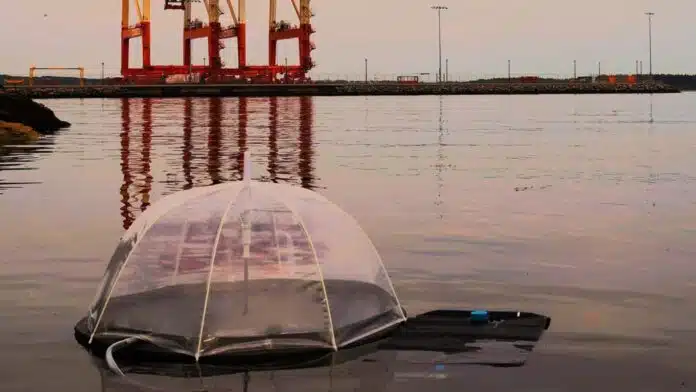
By Jay Kakade 3 Nov, 2024
Collected at: https://www.techexplorist.com/dalhousie-researchers-create-solar-powered-floating-water-purifier/91885/
Researchers at Dalhousie University have developed a plasmonic nanoparticle-based floating system that can offer a reliable alternative to freshwater production. This portable solar-powered prototype uses old tires to float on saline water sources and starts harvesting clean water instantly.
There is a superabundance of water on Earth but a significant lack of access to clean drinking water. While techniques like thermal distillation or reverse osmosis purify saltwater, their high energy consumption and economic investments restrict their use.
However, the new device is low-infrastructure, eco-friendly, and requires no land for deployment. Additionally, it can generate a small amount of thermoelectricity and simultaneously desalinate, disinfect, and decontaminate the water.
When deployed, the system brings ocean water up to the foam surface of the device. Here, photothermal nanomaterials convert sunlight into heat, which is used for evaporation.
After separating the salt, water recondenses on the clear plastic dome of the device. Then water is funneled down to the sides where it’s collected in a sealed bag. The harvested clean water is tested for microbe activity and a variety of potential contaminants found in the source water.
“Maximizing the use of sunlight means our plasmonic solar still can generate large amounts of water while maintaining a simple design. It’s exciting to showcase the effectiveness of the still on a real-world scale and prove that this type of device has the potential to bring freshwater to places that desperately need it,” says Dr. Margeson.
Researchers have tested the floating still on Halifax Harbour, which resulted in daily water yields of up to 3.67 L. This is a world record for a passive floating solar still.

Most of the water generation systems use precious metals like gold and silver as plasmonic materials. Even though they are high-performing, they are expensive.
Dr. Mita Dasog wants to create inexpensive and simple devices for better and wider applications. Therefore, researchers are eyeing earth-abundant materials that would not compromise performance.
“We shouldn’t be making an expensive or very complicated device,” says Dr. Dasog. “It has to be easy to manufacture, last for a long time, and be easy to take apart and move.”
Journal Reference
- Margeson, M. J., Atwood, M., De Larrea, J. L., Weatherby, J., Daurie, H., Near, K., Gagnon, G. A., & Dasog, M. (2024). Refractory Plasmonic Material based Floating Solar Still for Simultaneous Desalination and Electricity Generation. IScience, 111225. DOI: 10.1016/j.isci.2024.111225

Leave a Reply